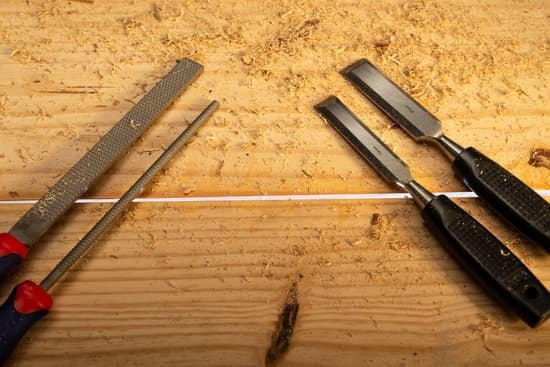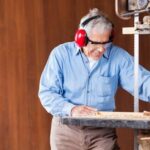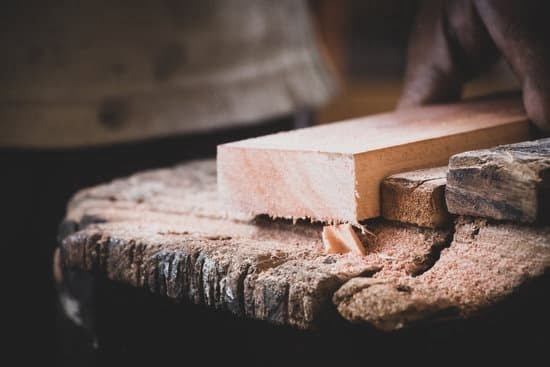Woodworking often requires the creation of precise angles, and one of the most common and crucial angles is the inner 90 degree angle. Proper support is essential in ensuring that these angles are accurately formed and stable. In this article, we will explore how to support inner 90 degree angles in woodworking, offering valuable insights and practical tips for achieving flawless results.
Whether you are working on a small-scale DIY project or a large-scale woodworking venture, understanding the importance of supporting inner 90 degree angles is paramount. Without proper support, these angles can easily become misaligned or unstable, leading to a flawed final product. From tools and materials needed to step-by-step guides on using clamps, braces, and support blocks, we will cover every aspect of providing adequate support for internal right angles in your woodworking projects.
In the upcoming sections, we will delve into various techniques and methods for supporting inner 90 degree angles in woodworking. From using squares and measuring tools to ensure precision to reinforcing and securing angles with screws and glue, we will equip you with everything you need to master this fundamental aspect of woodworking. Additionally, our expert tips and tricks will provide valuable insights for avoiding common mistakes and achieving impeccable results in your woodworking endeavors.
Tools and Materials Needed to Support Inner 90 Degree Angles
When working with inner 90 degree angles in woodworking, it is crucial to have the right tools and materials to ensure a precise and secure joint. The following section will outline the essential items needed to support inner 90 degree angles effectively.
Clamps
Clamps are a fundamental tool for supporting inner 90 degree angles in woodworking. They come in various types, including bar clamps, C-clamps, and quick-release clamps. These tools exert pressure to hold two pieces of wood together at a perfect right angle during assembly and glue-up.
Squares and Measuring Tools
Accurate measurement is key to achieving a perfect 90 degree angle. Squares, such as combination squares and speed squares, are essential for checking the accuracy of the angle during assembly. Other measuring tools, like rulers and tape measures, are also necessary to ensure that the components are cut to the correct length for a precise fit.
Braces and Support Blocks
Braces and support blocks provide additional reinforcement when supporting inner 90 degree angles, especially in larger or heavier woodworking projects. They can be used to temporarily hold the pieces in place while the glue dries or as a safety measure during assembly.
In addition to these tools, it is important to have high-quality wood glue, screws or nails, and a workbench with sufficient space for maneuvering the materials. By having these tools and materials on hand, you can effectively support inner 90 degree angles in your woodworking projects with confidence and precision.
Step-by-Step Guide on Using Clamps to Support Inner 90 Degree Angles
When it comes to woodworking, ensuring that your inner 90 degree angles are properly supported is essential for the structural integrity of your project. One of the most common and effective ways to support inner 90 degree angles in woodworking is by using clamps. Clamps provide a reliable and secure method for holding pieces together at a precise right angle while glue dries or screws are inserted.
Choosing the Right Clamps
Before starting, it’s important to choose the right type of clamp for supporting inner 90 degree angles. In most cases, bar clamps or quick-release clamps work best for this purpose. Make sure that the clamp has enough depth and pressure to securely hold the pieces together without causing any damage.
Positioning and Securing the Clamps
Once you have chosen the appropriate clamps, position them on the workpiece so that they create a perfect 90 degree angle between the two pieces. It’s important to ensure that both pieces are aligned properly before tightening the clamps. Once in position, gradually tighten each clamp to apply even pressure on both pieces without shifting their alignment.
Checking for Accuracy
After securing the clamps, double-check that the inner 90 degree angle is perfect using a carpenter’s square or a precision measuring tool. Making sure that everything is perfectly aligned before allowing any glue or screws to set will help avoid any potential issues down the line.
By following these step-by-step guidelines on using clamps to support inner 90 degree angles in woodworking, you can ensure that your projects are structurally sound and professionally finished.
Tips for Using Braces and Support Blocks for Inner 90 Degree Angles
When it comes to woodworking, ensuring that inner 90 degree angles are properly supported is crucial in creating strong and durable structures. Using braces and support blocks can help achieve this, providing stability and reinforcement for your woodworking projects. Here are some tips for effectively using braces and support blocks for inner 90 degree angles:
- Choose the right materials: Select sturdy and straight lumber or plywood for making your braces and support blocks. Using high-quality materials will ensure that they provide adequate support for the 90 degree angles.
- Measure and cut accurately: Before cutting your braces and support blocks, carefully measure the dimensions needed for the specific angle you are working with. Use a reliable measuring tool, such as a combination square, to ensure accuracy.
- Positioning of braces: When using braces to support an inner 90 degree angle, make sure that they are positioned diagonally across the corner of the angle. This will provide maximum support and prevent any movement or shifting.
Support blocks:
- Select appropriate size: Choose support blocks that are of sufficient size to provide solid reinforcement to the inside corner of the angle. The block should snugly fit into the corner without causing any gaps.
- Secure placement: Once you have positioned the support blocks, use clamps or screws to secure them in place. This will prevent any movement during the woodworking process.
- Proper spacing: When installing multiple support blocks along a long 90 degree angle, ensure that they are evenly spaced to provide consistent reinforcement throughout the length of the angle.
By following these tips, you can effectively use braces and support blocks to ensure that inner 90 degree angles in your woodworking projects are adequately supported, resulting in strong and precisely constructed structures.
Expert Tip: Experiment with different types of braces and support block configurations to find which method works best for each specific project.
Techniques for Using Squares and Measuring Tools to Ensure a Perfect 90 Degree Angle
Understanding the importance of supporting inner 90 degree angles in woodworking is crucial to ensure the structural integrity and overall quality of your project. Whether you are building furniture, cabinets, or other wooden structures, ensuring that your angles are perfectly square is essential for a professional finish.
When it comes to tools and materials needed to support inner 90 degree angles, there are a few key items that every woodworker should have in their workshop. A good quality combination square, a speed square, and a reliable measuring tape are essential for accurately marking and measuring 90 degree angles. Additionally, having a reliable set of clamps, braces, support blocks, screws, and glue will also be necessary for properly supporting and reinforcing these angles.
One effective technique for ensuring a perfect 90 degree angle is using squares and measuring tools. To do this, start by using your combination square or speed square to mark the 90 degree angle on both pieces of wood that need to be joined.
Then, use a measuring tape to check that both sides are equal in length from the corner to ensure that the angle is indeed 90 degrees. By taking the time to measure and mark carefully, you can guarantee that your joinery will be accurate and strong.
| Tools | Materials |
|---|---|
| Combination Square | Clamps |
| Speed Square | Braces |
| Measuring Tape | Support Blocks |
This attention to detail will ultimately result in higher quality woodworking projects with tight-fitting joints that are not only structurally sound but also visually appealing. Mastering these techniques for ensuring perfect 90 degree angles will elevate your woodworking skills and set you apart as an expert craftsman.
How to Reinforce and Secure Inner 90 Degree Angles With Screws and Glue
When it comes to woodworking, reinforcing and securing inner 90 degree angles is crucial for ensuring the structural integrity and stability of your project. Proper reinforcement and securing techniques will also help prevent joints from coming apart over time. In this section, we will discuss how to effectively reinforce and secure inner 90 degree angles using screws and glue.
It’s important to have the right tools and materials on hand before you begin working on reinforcing and securing inner 90 degree angles. Here are some essential items you will need:
- Clamps
- Screws
- Wood glue
- Screwdriver or drill
- Sandpaper
Once you have gathered your tools and materials, follow these step-by-step guidelines on how to reinforce and secure inner 90 degree angles with screws and glue:
- Apply a generous amount of wood glue to the joint where the two pieces of wood meet at a 90 degree angle.
- Use clamps to hold the pieces together firmly while the glue sets.
- Once the glue has dried, pre-drill holes for screws at regular intervals along the joint.
- Carefully drive screws into each pre-drilled hole to further reinforce the joint.
By following these techniques, you can ensure that your inner 90 degree angles are properly reinforced and secured, providing a strong foundation for your woodworking projects.
Common Mistakes to Avoid When Supporting Inner 90 Degree Angles
When working with inner 90 degree angles in woodworking, there are several common mistakes that should be avoided to ensure a successful and professional outcome. One of the most common mistakes is not using the correct tools and materials to provide adequate support for the angle. Without the proper support, the angle may become distorted or misaligned, leading to a subpar finished product.
Another mistake to avoid is relying solely on clamps to support inner 90 degree angles. While clamps are useful in many woodworking projects, they may not always provide enough support for an inner angle. It is important to also utilize braces and support blocks as needed to reinforce the angle and prevent any movement during the construction process.
Additionally, failing to double-check and confirm that the angle measures exactly 90 degrees before securing it with screws and glue can lead to irreparable errors in woodworking projects. Taking the time to use squares and other measuring tools to ensure the angle is accurate will save time and frustration in the long run.
Lastly, a common mistake when supporting inner 90 degree angles is rushing through the process. Woodworking requires precision and attention to detail, so taking your time and being patient throughout each step will result in a better overall outcome.
| Common Mistakes | How to Avoid |
|---|---|
| Not using correct tools and materials | Ensure proper support by using appropriate tools such as clamps, braces, support blocks, squares, etc. |
| Relying solely on clamps for support | Utilize braces and support blocks as needed for additional reinforcement of the inner angle |
| Failing to measure accuracy of 90 degree angle | Take time to use squares and measuring tools before securing with screws and glue |
Expert Tips and Tricks for Mastering the Art of Supporting Inner 90 Degree Angles in Woodworking
In conclusion, understanding the importance of supporting inner 90 degree angles in woodworking is essential for creating strong and reliable structures. By using the right tools and materials, such as clamps, braces, support blocks, squares, measuring tools, screws, and glue, woodworkers can ensure that their projects have precise and sturdy inner 90 degree angles.
One effective way to support inner 90 degree angles in woodworking is by using clamps. By following a step-by-step guide on how to use clamps properly, woodworkers can easily secure their workpieces at a perfect 90 degree angle. Additionally, utilizing braces and support blocks can provide extra reinforcement to ensure that the angles remain accurate and stable throughout the woodworking process.
Another crucial aspect of supporting inner 90 degree angles is using squares and measuring tools to double-check the accuracy of the angles. This step is vital for achieving a flawless end result.
Furthermore, reinforcing and securing the inner 90 degree angles with screws and glue can add an extra layer of strength to the structure. By avoiding common mistakes and implementing expert tips and tricks, woodworkers can master the art of supporting inner 90 degree angles in their woodworking projects effectively.
Ultimately, mastering the techniques for supporting inner 90 degree angles in woodworking requires practice and attention to detail. With patience and dedication, woodworkers can achieve perfectly aligned inner 90 degree angles in their projects, resulting in professional-quality craftsmanship.
Frequently Asked Questions
How Do You Secure a 90 Degree Angle?
Securing a 90-degree angle can be done by using corner clamps or an adjustable angle clamp to hold the pieces in place while you drill, glue, screw, or nail them together. Additionally, using a square to ensure that the angle is accurate before securing it can help maintain the right angle.
How Do You Reinforce a Miter Joint?
Reinforcing a miter joint can be achieved by adding splines, biscuits, or dowels to the joint to provide additional strength and durability. Another option is to use reinforcing plates or brackets on the outside of the joint for added support. This will help prevent the joint from coming apart over time.
How Do You Attach Wood to a 90 Degree Angle?
When attaching wood at a 90-degree angle, one common method is to use screws or nails driven through one piece of wood and into the end grain of the other piece. Alternatively, you can use glue and clamps to secure the pieces together until the adhesive dries.
Using pocket hole joinery or metal angle brackets are also effective ways to attach wood at a 90-degree angle.

Hi everyone! I’m a woodworker and blogger, and this is my woodworking blog. In my blog, I share tips and tricks for woodworkers of all skill levels, as well as project ideas that you can try yourself.





